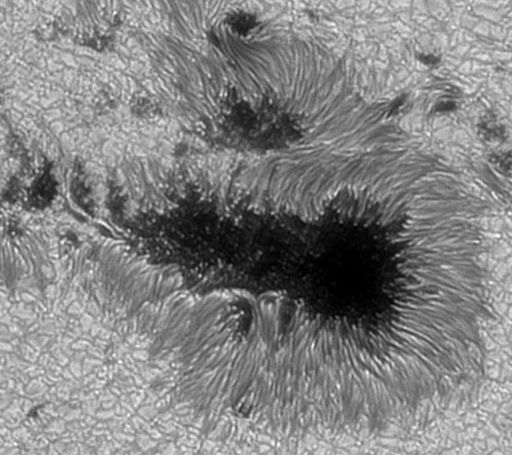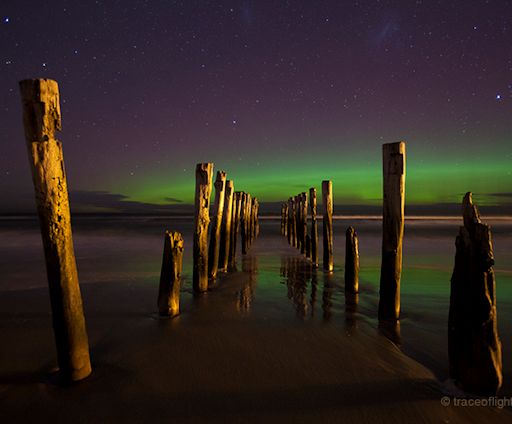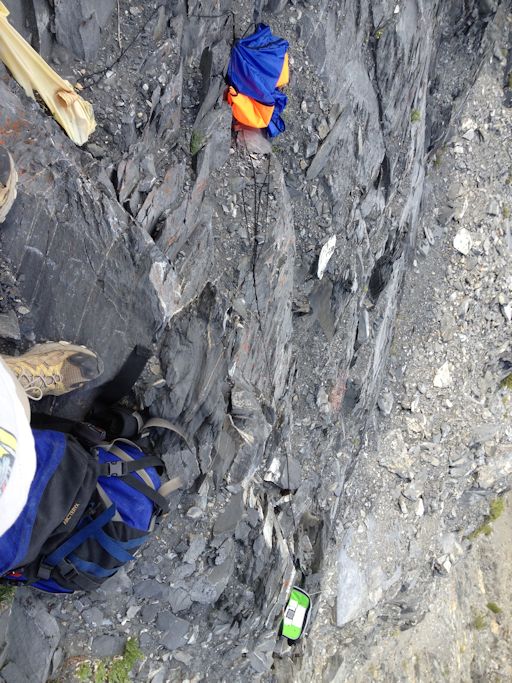When is the best time to see auroras? Where is the best place to go? And how do you photograph them? These questions and more are answered in a new book, Northern Lights - a Guide, by Pal Brekke & Fredrik Broms. | | |
BIG SUNSPOT FACES EARTH: Colossal sunspot AR1785 is now directly facing Earth. The active region has a 'beta-gamma-delta' magnetic field that harbors energy for X-class flares, yet so far the sunspot has been mostly quiet. Could it be the calm before the storm? NOAA forecasters estimate a 55% chance of M-flares and a 10% chance of X-flares on July 8th. Solar flare alerts: text, voice.
Sprawling more than 11 Earth-diameters from end to end, AR1785 is one of the biggest sunspots of the current solar cycle. In fact, it can barely fit on the screen. Click on the dark core below to see a complete hi-res picture taken by Christian Viladrich of Nattages, France:

To take the picture, Viladrich used a filtered 14-inch Celestron telescope. All those irregular blobs surrounding the primary dark core are boiling granules of plasma as small as the state of California or Texas. It's a very sharp picture. More images of the colossus may be found in the realtime gallery.
Realtime Sunspot Photo Gallery
SOUTHERN LIGHTS: On July 6-7, Earth passed through a region of interplanetary space with a south-pointing magnetic field. The encounter opened a crack in Earth's magnetosphere, allowing solar wind to flow inside. The resulting auroras were best seen in the wintry-dark skies of the southern hemisphere:

"These were the biggest auroras so far this year," says photographer Taichi Nakamura of Dunedin, New Zealand. "I rushed my 2 year old son and wife to finish their dinner, and I am glad I did. They enjoyed the show! It helped that the night was warmer than usual, not going under 0 degrees Celsius. I myself became so excited that I took more than 2500 shots."
More auroras could be in the offing. A slow-moving CME expelled from the sun on July 6th is expected to hit Earth's magnetic field on July 10th. Minor geomagnetic storms are possible when the CME arrives. Aurora alerts: text, voice.
Realtime Aurora Photo Gallery
SPACE WEATHER BALLOON CLIFFHANGER: On July 2nd a recovery team reached the payload of a space weather balloon launched on June 30th. It was the second attempt to retrieve the balloon from its mountainous landing site in the Sierra Nevada mountains of central California. The first attempt late on July 1st was aborted due to challenging terrain and fading sunlight. This time, the team started earlier and in the full light of midday they found the landing site. It turned out to be a cliffhanger:

As shown above, the payload was dangling from a shear cliff face more than 1400 feet above the foot of the Nevahbe Ridge. Super-climber Michael White, a member of the Earth to Sky Calculus student group that launched the balloon, was able to reach the landing site and snag the payload from the safety of a small ledge just above the parachute. The shoe in the photo belongs to Michael.
This balloon was launched at the peak of a record-setting heat wave in the southwestern USA, bringing temperatures as high as 128 F to desert areas around the launch site. The goal of the curiosity-driven flight was to discover whether the heat wave extended all the up to the Edge of Space. To help answer the question, the balloon's payload was outfitted with two HD video cameras, a pair of GPS trackers, a GPS altimeter, a cryogenic thermometer and an ozone sensor.
Students are analyzing the footage and data now. Stay tuned for results!
Realtime Space Weather Photo Gallery
Realtime Noctilucent Cloud Photo Gallery
[previous years: 2003, 2004, 2005, 2006, 2007, 2008, 2009, 2011]
Realtime Comet Photo Gallery

